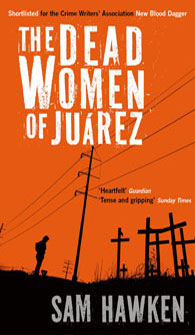 It’s a tricky thing, deciding to go ahead with a piece of fiction based on fact. There’s always the issue of whether the facts are broadly accepted (not always a given), and then there’s the potential to offend those for whom those facts are sacrosanct. Double these potential snags when you’re talking about events in another country, and events that affect a totally different demographic. You’re walking into a minefield.
It’s a tricky thing, deciding to go ahead with a piece of fiction based on fact. There’s always the issue of whether the facts are broadly accepted (not always a given), and then there’s the potential to offend those for whom those facts are sacrosanct. Double these potential snags when you’re talking about events in another country, and events that affect a totally different demographic. You’re walking into a minefield.
I first became aware of the issue of the feminicidios (female homicides) in the mid-’00s. Amnesty International USA started a campaign to draw attention to the problem and it worked with me. I was exposed to a part of Mexico that had previously been closed to me as an American and I was affected. I immediately knew that I had to write about it, but it would be a few years before I figured out how and what.
For those who aren’t aware: since the early 1990s there have been a serious of vicious murders and unexplained disappearances among the female population of Ciudad Juárez, a border city directly across the river from El Paso. The city enjoyed an economic boom with the advent of NAFTA, but in 1994 the homicide rate among women jumped 600%. Something terrible was happening and no one could figure out how or why. The criminal justice system in Mexico is virtually nonexistent, with successful prosecutions of murders in some states going as low as one percent. So it went on and on. And on.
Eventually this trend would be swallowed up by the outrageous violence of Mexico’s drug wars, but the evidence still remains that the feminicidios continue. This is a ongoing and serious Mexican women’s issue, and I as an American man, had to figure out a way to tell this story without insulting the very people whose problems I wished to illuminate. It was not easy.
I knew immediately that it would be folly to try and tell the story from the point of view of a woman. Maybe some male writers have the ability to put themselves firmly into the character of a woman while they write, but I did not trust my abilities in that regard. To that end, I conceived of a storyline where the murders would be experienced by two men, tied together through the memory of an extraordinary woman. This I knew I could do.
 I then faced another quandary: how to depict the murders themselves without sensationalizing them. There is much that is grotesque and sickening about the feminicidios and I could easily have exploited this in an effort to titillate the reader through the outrageous. Consequently I decided to concentrate on the thing that lingers after the raping and the mutilation and the killing is done: loss. Everyone understands loss, and the truth is that every murder in Juárez, whether man or woman, leaves the devastated behind.
I then faced another quandary: how to depict the murders themselves without sensationalizing them. There is much that is grotesque and sickening about the feminicidios and I could easily have exploited this in an effort to titillate the reader through the outrageous. Consequently I decided to concentrate on the thing that lingers after the raping and the mutilation and the killing is done: loss. Everyone understands loss, and the truth is that every murder in Juárez, whether man or woman, leaves the devastated behind.
People who read The Dead Women of Juárez will (hopefully) come to understand the tragedy of the female homicides through the futility of justice and the persistent agony of loss. In most of these cases, the friends and relations of the murdered have absolutely no recourse, definitely not through the law. The police either don’t care, or are too overwhelmed with other things to give the killings of these women any thought. As for those who seek justice on their own terms: where do they start? Who are the suspects? Where is the crime scene? What are the facts? Even these things are unknown. Dumped in a cotton field somewhere, or like trash outside one of Juárez’s many shanty “neighborhoods,” called colonias… there is nothing.
Getting this across to the reader is no easy task, and there are writers like Teresa Rodriguez, in books like The Daughters of Juárez, who have put my efforts to shame. I’m just a guy who tries to tell the truth through what is essentially an organized lie. If I can affect one person enough to go on to read the wealth of non-fiction out there and begin to care about a forgotten population in a foreign land, then I have succeeded in my modest goal. I never wanted to disgust someone, even though the story of the feminicidios is disgusting, and I never wanted to thrill someone with salacious details, though there are those for such readers as enjoy that kind of thing.
I suppose in the end all I wanted to do was make you, the reader, care. Someone has to.





Charles Wingfield
October 15, 2012 - 4:15 PM